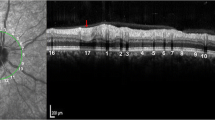Abstract
Purpose
Orthogonal polarization spectral (OPS) imaging is an optical imaging technique that uses a handheld microscope and green polarized light to visualize the red blood cells in the microcirculation of organ surfaces. The purpose of this study was to evaluate whether OPS imaging can be used for the functional and morphological evaluation of microcirculation in the conjunctiva.
Methods
To accomplish the aforementioned purpose, 21 eyes of 21 volunteer patients were examined. OPS images of the vasculature of the inferior conjunctiva and the nasal part of the bulbar conjunctiva were taken from each eye. The images were subsequently analyzed using a computer, and the following parameters were assessed: red blood cell velocity, blood vessel diameter, and functional capillary density. In addition, distinct qualitative aspects of the conjunctival microvasculature were characterized.
Results
OPS imaging facilitated both the observation of red blood cells that were flowing through conjunctival vessels on a white background, and the measurement of other quantitative and qualitative microvascular parameters. Significant differences between several measures of the inferior and nasal bulbar conjunctival microcirculations were found, including differences in the configurations of the vessel segments, the number of vessel segments, the number of bifurcations, the mean diffusion distance, and the functional capillary density.
Conclusions
OPS imaging can be used to measure the diameters of microvessels, functional capillary density, and other parameters. Significant differences between the microcirculations of the inferior conjunctiva and the nasal bulbar conjunctiva were found, which indicates the necessity of using a standardized approach to examine the conjunctival vasculature. OPS imaging is suitable for both the functional and morphological evaluation of the conjunctival microcirculation.





Similar content being viewed by others
References
Boerma EC, Mathura KR, van der Voort PH, Spronk PE, Ince C (2005) Quantifying bedside derived imaging of microcirculatory abnormalities in septic patients: a prospective validation study. Crit Care 9(6):R601–R606
Cheung AT, Chen PC, Larkin EC, Duong PL, Ramanujam S, Tablin F, Wun T (2002) Microvascular abnormalities in sickle cell disease: a computer-assisted intravital microscopy study. Blood 99:3999–4005
Cheung ATW, Perez RV, Chen PCY (1999) Improvements in diabetic microangiopathy after successful simultaneous pancreas-kidney transplantation: a computer-assisted intravital microscopy study on the conjunctival microcirculation. Transplantation 68:927–932
Cheung ATW, Price AR, Duong PL, Ramanujam S, Gut J, Larkin EC, Chen PCY, Wiltse SL (2002) Microvascular abnormalities in pediatric diabetic patients. Microvasc Res 63:252–258
De Backer D, Creteur J, Dubois MJ, Sakr Y, Vincent JL (2004) Microvascular alterations in patients with acute severe heart failure and cardiogenic shock. Am Heart J 147:91–99
De Backer D, Hollenberg S, Boerma C, Goedhart P, Büchele G, Ospina-Tascon G, Dobbe I, Ince C (2007) How to evaluate the microcirculation: report of a round table conference. Crit Care 11(5):R101
Fenton BM, Zweifach BW, Worthen DM (1979) Quantitative morphometry of conjunctival microcirculation in diabetes mellitus. Microvasc Res 18:153–166
Groner W, Winkelman JW, Harris AG, Ince C, Bouma GJ, Messmer K, Nadeau RG (1999) Orthogonal polarization spectral imaging: a new method for study of the microcirculation. Nat Med 5:1209–1212
Harris AG, Sinitsina I, Messmer K (2000) The cytoscan model E-II, a new reflectance microscope for intravital microscopy: comparison with the standard fluorescence method. J Vasc Res 37:469–476
Intaglietta M, Hammersen F (1986) Measurement of diameter in microvascular studies. In: Baker CH (ed) Microcirculatory technology. Academic Press, Orlando, pp 137–148
Klyscz T, Jünger M, Jung F, Zeintl H (1997) Cap image - a new kind of computer-assisted video image analysis system for dynamic capillary microscopy. Biomed Tech (Berl) 42(6):168–175
Korber N, Jung F, Kiesewetter H, Wolf S, Prunte C, Reim M (1986) Microcirculation in the conjunctival capillaries of healthy and hypertensive patients. Klin Wochenschr 64:953–955
Lack A, Adolph W, Ralston W, Leiby G, Winsor T, Griffith G (1949) Biomicroscopy of conjunctival vessels in hypertension. Am Heart J 38:654–664
Langer S, Harris AG, Biberthaler P, von Dobschuetz E, Messmer K (2001) Orthogonal polarization spectral imaging as a tool for the assessment of hepatic microcirculation: a validation study. Transplantation 71:1249–1256
Mathura KR, Bouma GJ, Ince C (2001) Abnormal microcirculation in brain tumours during surgery. Lancet 358:1698–1699
Mathura KR, Vollebregt KC, Boer K, de Graaff JC, Ubbink DT, Ince C (2001) Comparison of OPS imaging and conventional capillary microscopy to study the human microcirculation. J Appl Physiol 91:74–78
Pranskūnas A, Pilvinis V, Dambrauskas Ž, Rasimavičiūtė R, Milieškaitė E, Bubulis A, Veikutis V, Vaitkaitis D, Boerma EC (2012) Microvascular distribution in the ocular conjunctiva and digestive tract in an experimental setting. Med (Kaunas) 48(8):417–23
Rutherford WF, Panacek EA, Griffith JK, Green JA, Munger M, Bednarczyk E, Miraldi F, Fisher CJ Jr (1989) Prediction of changing cerebral blood flow by use of the conjunctival oxygen tension/arterial oxygen tension index. Crit Care Med 17(12):1328–1332
Sullivan JM, Prewitt RL, Josephs JA (1983) Attenuation of the microcirculation in young patients with high-output borderline hypertension. Hypertension 5:844–851
van Haaren PM, van Bavel E, Vink H, Spaan JA (2003) Localization of the permeability barrier to solutes in isolated arteries by confocal microscopy. Am J Physiol Heart Circ Physiol 285:H2848–H2856
Worthen DM, Fenton BM, Rosen P, Zweifach BW (1981) Morphometry of diabetic conjunctival blood vessels. Ophthalmology 88:655–657
Zeller C (1921) Studies on the conjunctival vessels. Klin Monatsbl f Ophthal 66:609
Grants
This research was supported by ‘Landelijke Stichting voor Blinden en Slechtzienden’ (LSBS), ‘Stichting Blinden-Penning’, and ‘Stichting Blindenhulp’.
Author information
Authors and Affiliations
Corresponding author
Rights and permissions
About this article
Cite this article
van Zijderveld, R., Ince, C. & Schlingemann, R.O. Orthogonal polarization spectral imaging of conjunctival microcirculation. Graefes Arch Clin Exp Ophthalmol 252, 773–779 (2014). https://doi.org/10.1007/s00417-014-2603-9
Received:
Revised:
Accepted:
Published:
Issue Date:
DOI: https://doi.org/10.1007/s00417-014-2603-9




